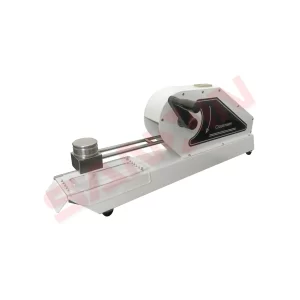MANUAL CROCK METER CM-100

A crock meter is a device used to measure the colorfastness of textiles to rubbing or abrasion. Below is an example of a detailed manual and catalog layout for a crock meter.
- INTRODUCTION
The crock meter is designed to test the transfer of color from the surface of textiles or other materials to another surface through rubbing. It is essential for evaluating the quality and durability of dyed or printed fabrics.
- APPLICATIONS
- Textiles and garments
- Leather and synthetic materials
- Painted or coated surfaces
- Upholstery
- SPECIFICATIONS
- Model: CM-100
- Rub Area: 10 cm x 10 cm
- Rubbing Load: 9 Newtons
- Stroke Length: 104 ± 3 mm
- Testing Speed: 60 strokes/min
- Dimensions: 280 mm x 180 mm x 250 mm
- Weight: 7 kg
- Standards Compliant: ISO 105-X12, AATCC 8, GB/T 3920
- COMPONENTS
- Main Body: Constructed from durable metal alloys.
- Abrasion Arm: Includes an adjustable holder for the rubbing finger.
- Rubbing Finger: Designed to accommodate standard testing cloth.
- Clamp Holder: Secures the test sample during operation.
- INSTALLATION INSTRUCTIONS
- Unpacking: Carefully remove the crock meter from its packaging and inspect for damage.
- Placement: Place the meter on a flat, stable surface.
- Attachment: Attach the rubbing finger securely to the abrasion arm.
- Power Supply: Plug in the power cord (if electronic).
- Initial Testing: Run a dry test to ensure functionality.
- OPERATING PROCEDURES
- Prepare the Sample: Secure the fabric or material in the sample holder.
- Attach the Test Cloth: Wrap a piece of standard white test cloth on the rubbing finger.
- Set Parameters: Adjust the stroke count and pressure as required.
- Start Test: Activate the machine for dry or wet rubbing tests.
- Record Results: Observe the transferred color on the white test cloth.

